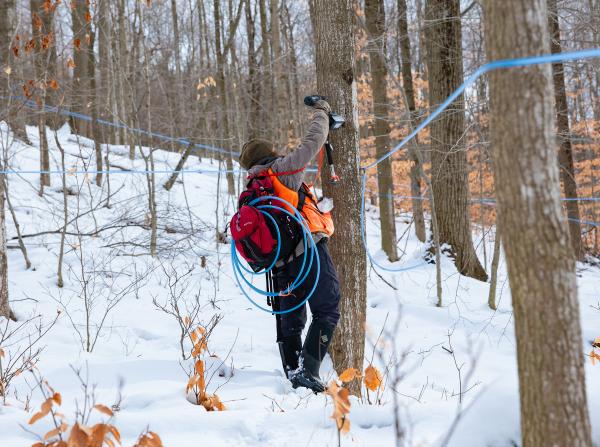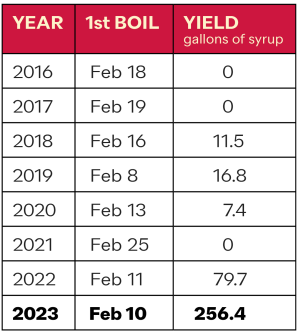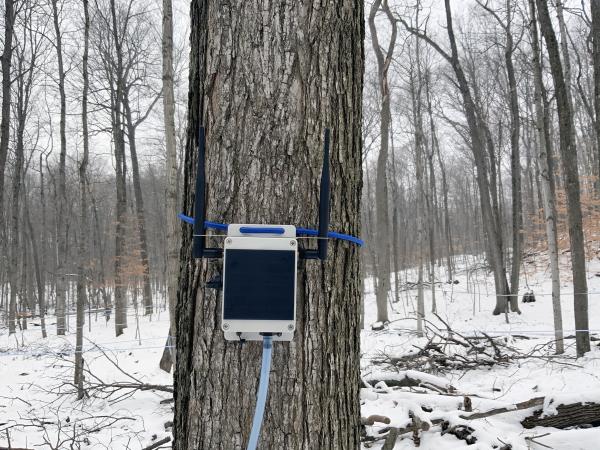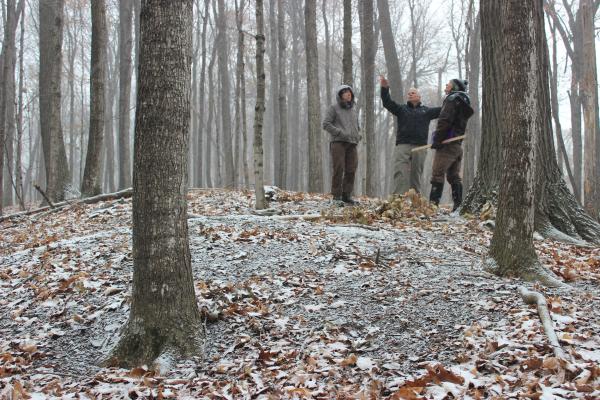Can't wait to have some of your syrup. Thank you for thinking of the future of the trees.
Maple Sugaring as the Climate Changes
This blog has been updated. Originally published February 2021. Marshall Webb, who was interviewed for this story, died unexpectedly in August 2022.
Maple sugaring has thrived in Vermont of late. We're the country’s leading producer, accounting for more than half of all maple syrup, and production in 2022 hit record high levels. But according to the University of Vermont's Proctor Maple Research Center, the average sugaring season in Vermont now begins 8 days earlier than it did 50 years ago, and one study forecasts that across the country, the sap collection season midpoint will be one month earlier by the year 2100.
Both anecdote and data confirm this for our farm. Former Woodlands Manager Marshall Webb said last winter, “We've been getting our first runs two or three weeks earlier than in the 50s when I started sugaring." He went on, "The traditional rule of thumb for Vermonters was that you had to be tapped by town meeting day to catch the first run. That's the first Tuesday in March. In the last several years, we've had significant runs mid-February.”
The season is wrapping up earlier, too, ending about 12 days earlier than it did 50 years ago. This means the sugaring season is shrinking overall: Vermont has lost more than 3 days of sugaring in this 50-year window. Across the sugar maple’s range, the further south you go, the more the season has been contracting.
Despite this, Vermont has still managed to boost maple syrup production in recent years. In 2022, it was an astounding 46% above the previous year's production! How is that possible? In a word, technology. Like many producers, Shelburne Farms has invested in collection tubing, a reverse osmosis machine, and a vacuum pump over the past decade. These technologies remove more sap from the trees, and help us process it more efficiently. We’re also tapping more trees (we have about 2,400 taps total) -- all of it to ramp up production and to tell a more modern story about what sugaring looks like today. So far, it’s worked.
Perhaps more troubling than the temporal shifts in sugaring is the predicted geographical shift. The same study expects that the region of maximum sap flow will shift northward by about 250 miles by 2100. That worried Marshall: “It takes hundreds and hundreds of years for a species to adapt to new conditions," he said last winter. "I don't know if the maples are going to have the vigor needed to produce good leaves, survive, and still produce the same amount of sap in the future.”
For him, the much longer term goal was not necessarily about preserving sugaring at all, but keeping forests that can still provide the same ecosystem services—as carbon sinks, wildlife habitat, and flood control. The makeup of those forests, he conceded, may favor warm-climate-loving species like oaks and hickories, which are already part of our diverse woodlands in the Champlain Valley.
Our current Woodlands Manager Dana Bishop is also concerned about our forests and sugarbush, although she suspects more than climate change is at work. Dana is troubled that she’s not seeing strong regeneration of sugar maples or other species. “We need sunlight to get to the ground so that we can encourage the next generation of trees,” she explains. “But when we harvest trees to allow in the sunlight, invasive species grow in. And if we keep the invasives out, then the deer eat the young tree seedlings. And if we keep the deer out, then the worms make the soil inhospitable." It's a chain of events that is proving challenging to disrupt.
“When I look at our woods,” Dana goes on, “I see beautiful trees, but I also see the lack of what's coming up for the generations ahead. Every time we do a harvest and nothing grows in its place, that worries me. But it's also hard to worry about because we’re tapping such beautiful trees and they're producing a lot of sap.” She chuckles, “So it's hard to see the forest for the trees!”
The challenges and dynamics of climate change and forests are enormously complex. Still, for now, sugaring at Shelburne Farms is “steaming” along, producing delicious syrup from a lot of sap. And overall, sugaring continues to be a bright light in Vermont agriculture, connecting people to the forests and working landscapes they rely on in so many different ways.
Here are a few highlights from our first day of sugarmaking in 2023:
Want some of this year's crop of maple syrup? We'll get to bottling it soon after the sugaring season is over, and will have some available at the Farm Store and online by May 1!
Further reading/listening: “Climate Change & Maple” a 2018 presentation by the UVM Proctor Maple Research Center.
See also, Vermont Agriculture and Food System Strategic Plan, 2030, from Vermont Farm to Plate
Comments
News about the Farm, sugaring and woodlot health are an oasis of grounding in a tumultuous world Your curbside pickup of produce and cooked dishes is another bright spot in any week.
Thank you so very much.
KFS
I observe the same phenomenon of change when I try to remove invasive plants or vines in the field next door, another aggressive species appears and moves in and spreads quickly to dominate. Each growing season I witness the struggle for survival of our native plants for spaces to grow and flourish, and the constant acceleration and overtaking of invasive species. I am in complete awe of what Nature shows us, the clear signs of change we see in the land and environment from year to year, and I wonder how much of those signs of change were influenced by some form of human activity. As I try to plant and make room for native wildflowers and pollinators, and pulling out invasive plants, I hope that I am working in accord with the natural course of Nature itself.
Thank you for this compelling story.




